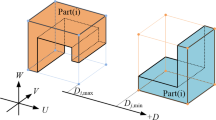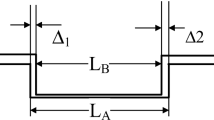Abstract
Interference matrix (IM) is an important assembly relation model to automate the assembly sequence planning (ASP). For a complex product with numerous parts, the creation of IMs is time consuming and error prone. Thus, a method is proposed to accurately and quickly generate IMs from a CAD assembly model. First, an improved IM model considering interference quantity is used to discriminate fake interference caused by CAD model errors. Second, the algorithm to automatically generate IMs is presented, in which a collision detection (CD) method is designed to quickly determine interference relationships between parts. This CD method involves three novel methods: extended cruciformly overlapped axis-aligned bounding boxes (COAABBs), improved pseudo face (PF) and hybrid facet projection intersection test. And a system called AutoAssem is utilized to implement the proposed method. Finally, the case study of a gearbox demonstrates that this method can extract IMs from the inaccurate CAD models for accurate ASP. Moreover, case studies of complex products like the milling machine verify that this method is much more efficient than the current methods and greatly shortens the data preprocessing time of ASP.
Similar content being viewed by others
References
Boothroyd G, Dewhurst P, Knight WA (2010) Product design for manufacture and assembly, third edn. CRC, Boca Raton
Zha XF, Samuel YEL, Fok SC (1998) Integrated knowledge-based assembly sequence planning. Int J Adv Manuf Technol 14(1):50–64
Rashid MFF, Hutabarat W, Tiwari A (2012) A review on assembly sequence planning and assembly line balancing optimisation using soft computing approaches. Int J Adv Manuf Technol 59(1–4):335–349
Jiménez P (2013) Survey on assembly sequencing: a combinatorial and geometrical perspective. J Intell Manuf 24(2):235–250
De Fazio TL, Whitney DE (1987) Simplified generation of all mechanical assembly sequences. IEEE J Robot Autom 3(6):640–658
Wilson RH (1995) Minimizing user queries in interactive assembly planning. IEEE Trans Robot Autom 11(2):308–312
Su Q (2007) Computer aided geometric feasible assembly sequence planning and optimizing. Int J Adv Manuf Technol 33(1–2):48–57
Miltrouchev P, Wang CG, LX L, Li GQ (2015) Selective disassembly sequence generation based on lowest level disassembly graph method. Int J Adv Manuf Technol 80(1):141–159
Wang Y, Tian D (2016) A weighted assembly precedence graph for assembly sequence planning. Int J Adv Manuf Technol 83(1):99–115
Dini G, Santochi M (1992) Automated sequencing and subassembly detection in assembly planning. Annals of the CIRP 41(1):1–4
Kuo TC (2000) Disassembly sequence and cost analysis for electromechanical products. Robot Comput Integr Manuf 16(1):43–54
Huang YM, Huang CT (2002) Disassembly matrix for disassembly processes of products. Int J Prod Res 40(2):225–273
Liu XH, Liu YH, BH X (2013) A converse method-based approach for assembly sequence planning with assembly tool. Int J Adv Manuf Technol 69(5–8):1359–1371
Gandhi S, Masehian E (2015) Assembly sequence planning of rigid and flexible parts. J Manuf Syst 36:128–146
Ou LM, Xu X (2012) Relationship matrix based automatic assembly sequence generation from a CAD model. Comput -Aided Design 45(7):1053–1067
Moez T, Riadh BH, Nizar A (2015) An interoperability CAD assembly sequence plan approach. Int J Adv Manuf Technol 79(9–12):1465–1476
Dong TY, Tong RF, Zhang L, Dong JX (2007) A knowledge-based approach to assembly sequence planning. Int J Adv Manuf Technol 32(11–12):1232–1244
Hsu YY, Tai PH, Wang MW, Chen WC (2011) A knowledge-based engineering system for assembly sequence planning. Int J Adv Manuf Technol 55(5–8):763–782
Smith GC, Smith S (2003) Automated initial population generation for genetic assembly planning. Int J Comput Integ Manuf 16(3):219–228
Wang Y, Liu JH (2010) Chaotic particle swarm optimization for assembly sequence planning. Robot Com-Int Manuf 26(2):212–222
Tseng YJ, FY Y, Huang FY (2011) A green assembly sequence planning model with a closed-loop assembly and disassembly sequence planning using a particle swarm optimization method. Int J Adv Manuf Technol 57(9):1183–1197
LD X, Wang C, Bi ZM, JP Y (2012) AutoAssem: an automated assembly planning system for complex products. IEEE Trans Ind Inform 8(3):669–677
Zhang HY, Liu HJ, Li LY (2014) Research on a kind of assembly sequence planning based on immune algorithm and particle swarm optimization algorithm. Int J Adv Manuf Technol 71(5–8):795–808
Wang JF, XH W, Fan XL (2015) A two-stage ant colony optimization approach based on a directed graph for process planning. Int J Adv Manuf Technol 80(5):839–850
Pan CX, Smith SS, Smith GC (2005) Determining interference between parts in CAD STEP files for automatic assembly planning. J Comput Inf Sci Eng 5(1):56–62
JP Y, Wang C (2013) Method for discriminating geometric feasibility in assembly planning based on extended and turning interference matrix. Int J Adv Manuf Technol 67(5–8):1867–1882
Perrard C, Bonjour E (2013) Unification of the a priori inconsistencies checking among assembly constraints in assembly sequence planning. Int J Adv Manuf Technol 69(1–4):669–685
JP Y, LD X, Bi ZM, Wang C (2014) Extended interference matrices for exploded view of assembly planning. IEEE Trans Autom Sci Eng 11(1):279–286
JP Y, Wang C (2013) A max-min ant colony system for assembly sequence planning. Int J Adv Manuf Technol 67(5–8):2819–2835
Llies HT (2009) Continuous collision and interference detection for 3D geometric models. J Comput Info Sci Eng 9(2):1–7
Tching L, Dumont G, Perret J (2010) Interactive simulation of CAD models assemblies using virtual constraint guidance. Int J Interact Des Manuf 4(2):95–102
Shi JC, Liu JH, Ning RX, Hou WW (2013) A collisions evaluation method in virtual environment for collaborative assembly. J Netw Comput Appl 36(6):1523–1530
Gao SM, Zhao W, Lin HW, Yang FQ, Chen X (2010) Feature suppression based CAD mesh model simplification. Comput -Aided Design 42(12):1178–1188
Jiménez JJ, Segura RJ (2008) Collision detection between complex polyhedra. Comput Graph 32(4):402–411
Weller R (2013) New geometric data structures for collision detection and haptics. Springer, Zurich
Peng GL, Hou X, Wu C, Jin TG, Zhang XT (2010) Fast collision detection approach to facilitate interactive modular fixture assembly design in a virtual environment. Int J Adv Manuf Technol 46(1–4):315–328
Bergen G (1997) Efficient collision detection of complex deformable models using AABB trees. J Graph Tools 2(4):1–13
Gottcshalk S, Lin MC, Manocha D (1996) OBB-tree: a hierarchical structure for rapid interference detection. Proc ACM SIGGRAPH Conf Computer Graph, New Orleans, pp. 171–180
Bradshaw G, O’Sullivan C (2004) Adaptative medial-axis approximation for sphere-tree construction. ACM Trans Graph 23(1):1–26
Jiménez P, Thomas F, Torras C (2001) 3D collision: a survey. Comput Graph 25(2):269–285
Feng YT, Li CF, Owen DRJ (2006) SMB:collision detection based on temporal coherence. Comput Methods Appl Mech Eng 195(19–22):2252–2269
Kieffer J, Litvin FL (1991) Swept volume determination and interference detection for moving 3-D solids. J Mech Des 113(4):456–463
Sulaiman HA, Othman MA, Saat MSM, Darsono AMB, Bade A, Abdullah MH (2014) Vector-based technique for distance computation in narrow phase collision detection. 1st International Symposium on Technology Management and Emerging Technologies (ISTMET). Bandung, Indonesia, pp 506–510
Baciu G, Wong WSK (2003) Image-based techniques in a hybrid collision detector. IEEE Trans Vis Comput Graph 9(2):254–271
Zhang WL, RX Q, MR X, Luo XC (2016) Method for automatic generation of assembly interference matrix of complex products. Journal of Mechanical Engineering 52(1):139–148 in Chinese
Author information
Authors and Affiliations
Corresponding author
Rights and permissions
About this article
Cite this article
Zhang, W., Ma, M., Li, H. et al. Generating interference matrices for automatic assembly sequence planning. Int J Adv Manuf Technol 90, 1187–1201 (2017). https://doi.org/10.1007/s00170-016-9410-x
Received:
Accepted:
Published:
Issue Date:
DOI: https://doi.org/10.1007/s00170-016-9410-x




